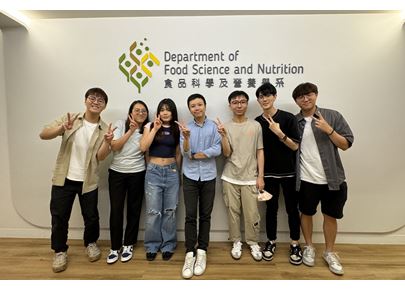Teachers' Sharing

between educator and student.
教學是一個雙向的過程——
一個讓導師與學生一同成長的旅程。

Dr Wong Ho-yin, Marcus
黃浩賢博士
Lecturer
Department of Food Science and Nutrition
食品科學及營養學系講師

Inspiration from My Teaching Journey at PolyU: Embracing Change and Fostering Engagement
This year marks my fifth year of teaching at PolyU, and I remain genuinely thrilled to have the privilege of working at my alma mater. It is a special honour to serve as one of the teachers guiding students in the very same programme from which I graduated. As a relatively new teacher, I may not be best positioned to articulate a fully developed teaching philosophy, but I am happy to share the thoughts and experiences that have shaped my approach to teaching so far.
It is undeniable that the way students learn has transformed over the past decade. I still recall my early days as a teaching assistant during my postgraduate studies, when students relied on printed lecture notes and scribbled in notebooks. Today’s classroom, by contrast, often resembles a mini computer lab, with students absorbed in the glow of their laptop or phone screens. Technology has reshaped many aspects of our lives, and teaching is no exception. We have adopted, or been encouraged to adopt, a variety of pedagogical strategies aimed at capturing students’ attention (and perhaps maintaining class attendance), enriching their learning experiences, and improving the overall effectiveness of instruction. Yet, despite these evolving methods and modes of delivery, my core beliefs in education remain unchanged.
From my experiences as both a student and a teacher, I have come to believe that students are most engaged when they develop a genuine interest in the subject matter. Unlike traditional basic sciences, which often revolve around abstract theories and fundamental laws, food science blends biology, chemistry, and physics with real-world applications such as nutrition, food safety, and product development. This integration creates a tangible bridge between scientific concepts and daily life, making the material more relatable and stimulating. To nurture this connection, I enrich my teaching with real-life examples that bring clarity to complex ideas, helping students see how textbook knowledge applies in the real world. For example, when teaching food safety, I might reference recent news about foodborne illness outbreaks or explain the science behind common food products. I believe that using relatable examples is essential in science education, not only to spark curiosity but also to help students internalize key principles and apply them to problem-solving and innovation.
I see teaching as a two-way process—a shared journey between educator and student. Instead of dominating the conversation, I encourage students to learn from one another, offering their own perspectives and questions. To support this collaborative environment, I incorporate interactive elements such as case discussions, UReply, and MS Forms alongside traditional lectures. These tools help foster a classroom atmosphere where students feel safe and motivated to contribute. This dialogue is not only beneficial for their learning; it also helps me identify areas that need more explanation or clarification, allowing me to adjust my approach to better suit their needs.
In science education, much of the learning takes place beyond the classroom — inside the laboratory, where students gain hands-on experience and bring scientific concepts to life. There, I demonstrate techniques, observe students’ grasp of experimental principles and ask questions that probe their understanding. These observations are invaluable in assessing the effectiveness of my teaching. I also use lab sessions as opportunities for informal advising, where students can speak freely about their academic challenges, internship plans or career aspirations. These conversations are a meaningful way to deepen the educational experience while fostering a sense of belonging and engagement.
As a programme leader and academic advisor, I deeply value the relationships I build with my students. Watching them grow, overcoming challenges, completing their studies and then succeeding in their careers, is profoundly rewarding. Teaching is my lifelong vocation, a journey that contributes not only to my students’ development but to my own personal and professional growth. I remain deeply grateful for the opportunity to learn and evolve alongside them.
理大教學旅程的啟發:乘變啟航,沃育參與
今年是我在理大任教的第五年,我很榮幸可以回到母校工作,而且能夠成為我的畢業學系學生的指導老師之一。作為一名相對較新的教師,我可能還未能完整地表達我的教學理念,但我仍很樂意分享迄今為止塑造我的教學方法的理念和經歷。
無可否認的是,過去十年學生的學習方式出現了不少變化。我還記得當我還是研究生時擔任助教的一些經歷,當時的學生還拿著印刷本講義在筆記簿上抄寫重點。相較之下,如今的教室就像一個小型電腦實驗室,學生們都全神貫注地看著平板電腦或手機螢幕。科技重塑了我們生活的不同範疇,教學亦不例外。我們一直採用(理大亦一直鼓勵)不同的教學策略,吸引學生的注意力(並保持課堂的出席率),為他們帶來豐富的學習體驗,同時提高整體教學效果。然而,雖然這些方法和授課方式不斷轉變,我對教育的核心信念仍然沒有改變。
根據我作為學生和老師的經驗,我相信當學生對某學科真正產生興趣時,他們都會表現得極為投入。與一般圍繞抽象理論和基本定律的傳統基礎科學不同,食品科學將生物學、化學和物理學與營養、食品安全和產品開發等實際應用互相融合。而這種融合在抽象的科學概念和日常生活之間架起了一座有形的橋樑,令教學內容更具相關性和啟發性。為了培養出這種學習環境,我經常使用現實生活例子來令我的教學內容變得豐富,清晰和簡化複雜的思路,以幫助學生了解課本知識如何於現實世界中應用。例如,在教授食品安全時,我會參考食源性疾病爆發的最新消息或解釋常見食品背後的科學原理。我相信在科學教育中使用相關的例子十分重要,這不僅可以激發好奇心,還可以幫助學生熟習一些重要理論並將其應用於解決問題和創新。
我認為教學是一個雙向的過程——一個讓導師與學生一同成長的旅程。我不會單方面不停授課,而是鼓勵學生互相學習,提出自己的觀點和問題。為了培養這種互動性,我在傳統授課之外還加入了一些案例討論、UReply 和 MS Forms 等互動元素。這些工具都有助營造一種讓學生感到安全並有動力發表意見的課堂氣氛。這種互動不單有利於他們的學習,還可以讓我得知需要加以解釋或澄清的地方,讓我能夠調整方法滿足學生的求學需求。
在科學教育的世界裡,大部分學習都是在課室以外進行的。在實驗室裡,學生可以獲得實戰經驗,並將科學概念實踐其中。當中,我會展示實驗技巧,觀察學生對科學原理的掌握,並提出問題來測試他們對理論的理解。這些觀察對於評估我的教學效果非常有價值。我還把握機會在實驗課期間和學生閒談,讓他們自由談論在學術上面對的困難、實習意向或工作計劃。這些都可以讓課堂體驗變得更加有趣,同時培養學生的歸屬感和參與感。
身為課程主任和學業指導,我非常重視與學生建立的關係。看著他們成長,慢慢克服挑戰、完成學業、然後在事業上取得成功,都是非常具意義的。教學是我的終生職業,這段旅程不僅可以培育學生,亦有助我個人和職業不斷成長。能夠有機會與他們一起學習和進步,我感激不已。


